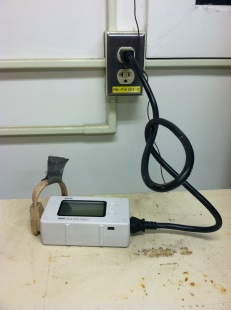Track Energy Consumption to Cut Utility Costs and Reduce Carbon Footprint
Data Loggers Case Study (Summer 2014)
During the summer of 2014, the Sustainability Task Force used data loggers in select labs, the Data Center, and various offices throughout WHOI to measure their baseline energy use. This information helped identify the largest sources of energy consumption, resulting in subsequent staff behavioral changes. For example, the loggers recorded energy usage of ovens, refrigerators, and freezers in Coastal Research Lab (CRL) 105, which gave the scientists and lab managers an estimate of how much their equipment costs to run. From this, we calculated potential savings arising from simple changes in equipment use such as powering down specific pieces of equipment more often. This case study highlights the benefits of conducting energy assessments of workspaces because it gives the scientists and lab managers a clear idea of how much energy their lab uses and the steps they can take to help WHOI save money and reduce its carbon footprint.
The data loggers were left on each piece of equipment for 24 hours to measure the amount of energy used over a full daily cycle.
To calculate electricity bill/cost per year this equation was used:
E(kWh/day) = P(W) × t(h/day) / 1000(W/kW)
Then:
Cost($/day) = E(kWh/day) × Cost(cent/kWh) / 100(cent/$)
Coastal Research Lab 105
| Equipment | Watts | Hours of Use/day | # Months in Use | Price ($)/ kWh | Price ($)/ year to Run |
|---|---|---|---|---|---|
Fisher Scientific small combustion oven | 860 | 4 | 12 | .17 | 210.48 |
Fisher Scientific large drying oven | 149.79 | 24 | 12 | .17 | 223.07 |
Large upright refrigerator | 250 | 24 | 12 | .17 | 367.2 |
Chest Freezer#1 | 242.31 | 24 | 12 | .17 | 355.9 |
Chest Freezer #2 | 242.32 | 24 | 12 | .17 | 355.92 |
Before conducting this study lab users had been keeping ovens switched on for hours at a time, even when empty. In addition, the two chest freezers that belong to another lab, but located in their space, have been running 24 hours/day for the past 10 years, despite being full of samples that could be archived or discarded. These calculations drew the lab scientists’ attention for both the potential monetary and environmental costs of having their equipment running. It also quantified the savings that could be realized by changing equipment use and lab behavior.
Data Influences Behavior
In response to this data, the occupants of CRL 105 have begun to:
- Turn off ovens when not in use
- Power down computers at night
- Close hood sashes
- Make efforts to clear out old freezers so these inefficient models can be turned off or recycled, thereby freeing up limited lab space
The Sustainability Task Force encourages others to make this simple assessment of their lab or work space in order to identify large sources of energy consumption and to make the effort to power down equipment that will help WHOI reduce its carbon footprint. If you are interested, please contact Facilities to learn how you can borrow and use a data logger.
“The mission of many scientists at WHOI is to understand long-term change and the myriad impacts humans are having on our planet. If, on an individual level, we do simple things in our labs to cut back on energy consumption and reduce carbon emissions, then we are aligning our behaviors and values with our mission and everybody benefits!” (Stephanie Madsen, CRL 105).
